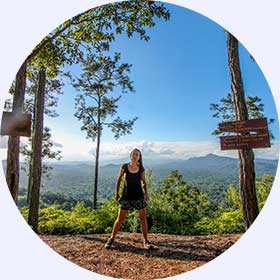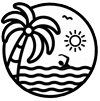Lagunas de Ruidera
Beautiful wetland composed of 15 deep blue lagoons and a reservoir. They are connected by streams and waterfalls. Located between the provinces of Albacete and Ciudad Real (Spain).
The Natural Park of the Lagunas de Ruidera is the most beautiful wetland of the Iberian Peninsula. They are located in a line of about 25 km, halfway along which lies the village of Ruidera. Of the 15 lagoons, 4.5 belong to Ciudad Real and 9.5 to Albacete. The Guadiana River is born here. The water in the lagoons comes from springs on the slopes, streams and groundwater. The difference in altitude between them results in water flowing from one lagoon to another via streams and waterfalls.
The first set of lagoons are called the high lagoons because they are upstream (although they are the most southerly). They are the Blanca, Concejo, Tomilla and Tinaja lagoons. The water comes from the river Pinilla and from an aquifer in the subsoil, which is fed by rain. Hence the waterfalls do not always carry water, it depends on the year and the season. Between Tinaja and Tomilla is the ‘Plaza de Toros’, the most beautiful karst formation in the Park. The water falls into a deep blue-green lagoon.
Downstream are the 8 middle lagoons: San Pedro, Redondilla, Lengua, Salvadora, Santos Morcillo, Batana, Colgada and del Rey. They are fed mainly by a stream and the preceding lagoons. They are the best for bathing and other water activities, due to their clean, clear waters, greater depth and limited vegetation on the edges. They are surrounded by hotels, campsites and restaurants. Laguna del Rey (the most popular) is the closest to Ruidera village. If you go up to the Laguna del Rey viewpoint, you will have breathtaking views. El Hundimiento waterfall (8 m high) is the most spectacular one. It is 100 m from Ruidera, between the lower and middle lagoons. The middle lagoons have tuffaceous barriers at the edges which form the cascades. The Laguna Colgada is the largest and most beautiful lagoon for many. The San Pedro lagoon is ideal for kayak rides (see below the Things To Do section).
The lower lagoons (130 m lower than the higher ones) have more mud and silt. They include the Morenilla, Coladilla and Cenagal lagoons. They are fed by the waterfalls and lagoons upstream.
At the end of this string of lagoons is the Peñarroya reservoir. It collects water from all the lagoons.
One of the main attractions of the Lagunas de Ruidera is bathing in its crystal-clear waters during the summer. Only some of the lagoons have bathing areas. These are signposted, accessible and are equipped with all kind of services. There are bathing areas in Laguna del Rey, Colgada, Santos Morcillo, Salvadora, Redondilla and San Pedro.
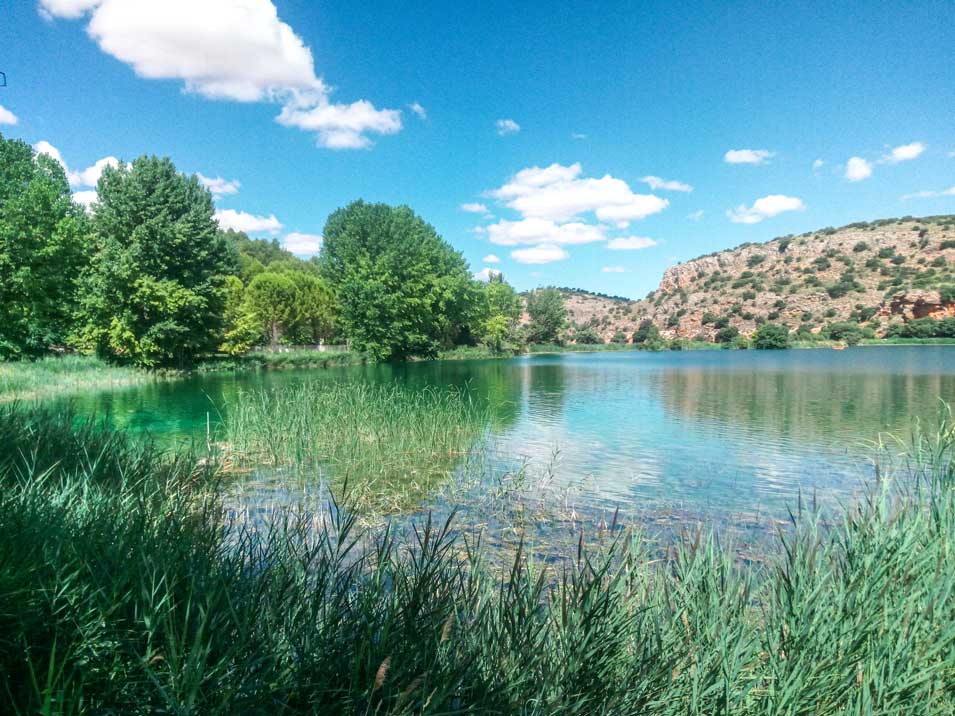
This area is a complex river network with a multitude of streams and waterfalls. The most common plant is the reed.
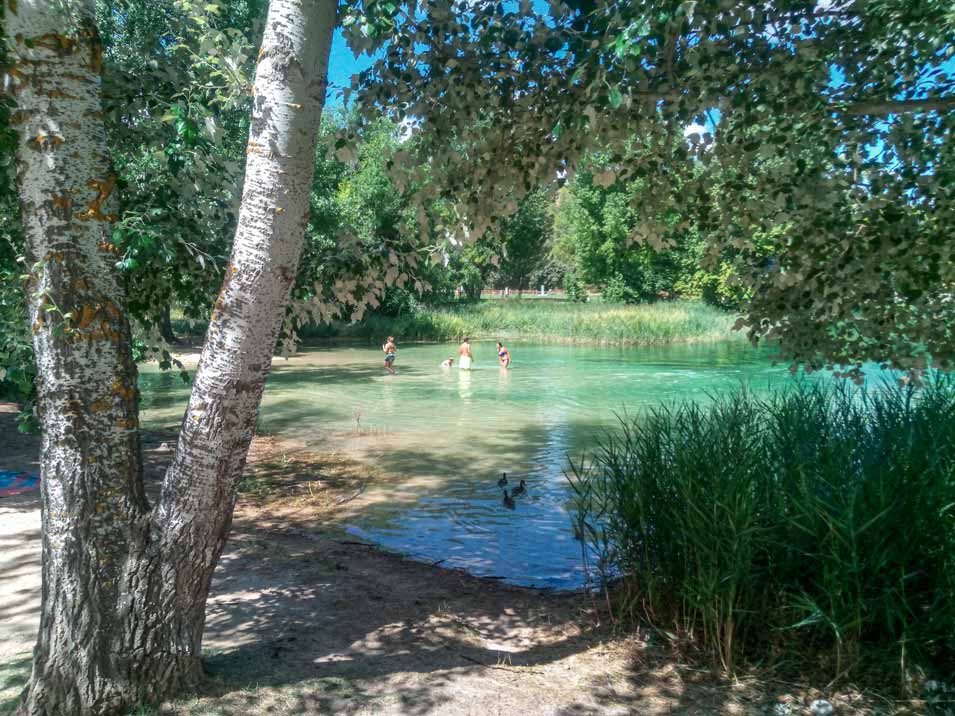
Some areas of the middle lagoons are like paradise beaches.
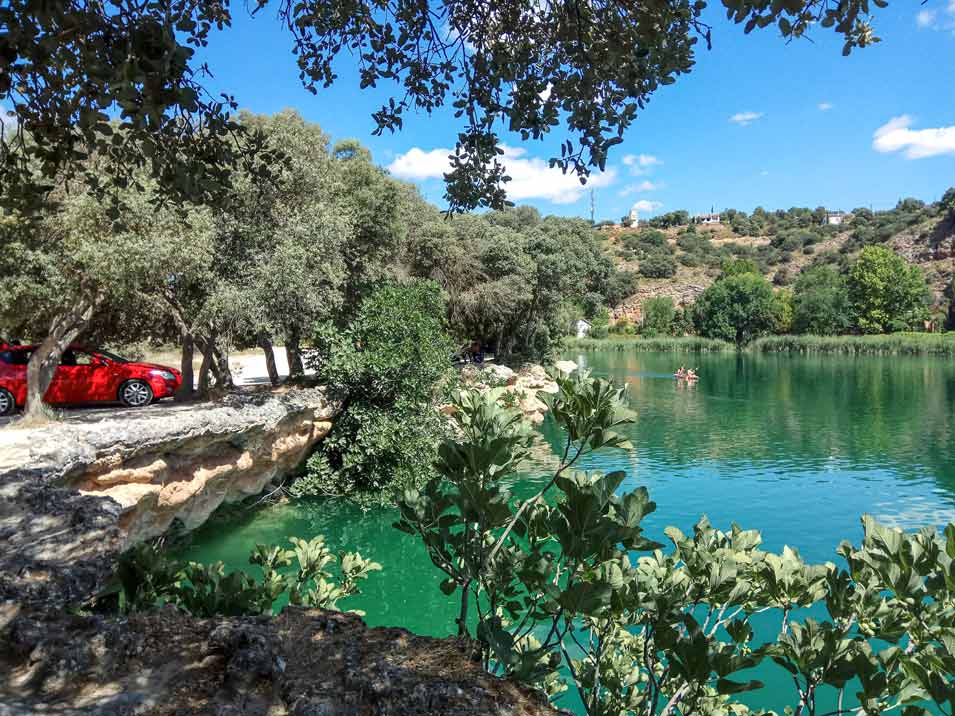
The road runs along the lagoons, passing by viewpoints on the way. These are ideal for contemplating the beauty of this unique site.
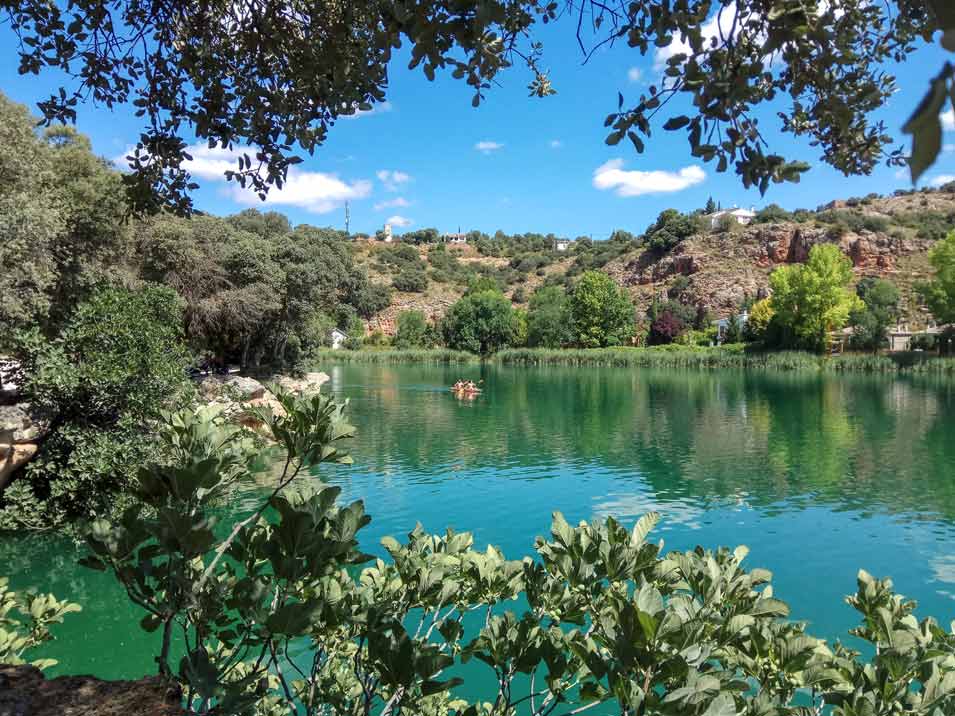
The middle lagoons are deeper and ideal for water sports such as kayaking.
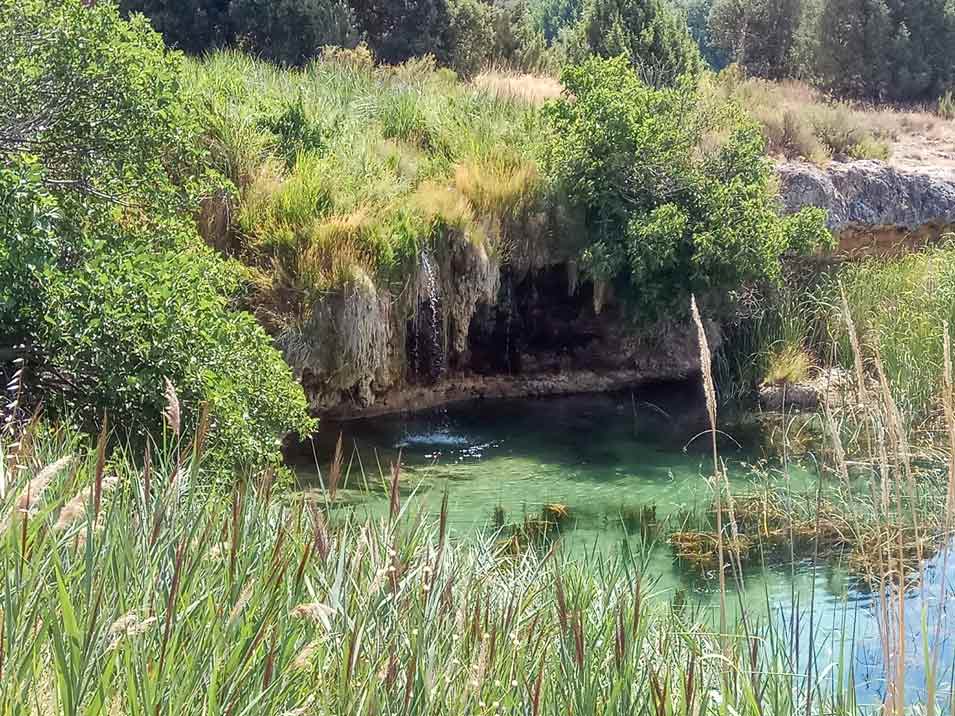
Tufa barriers separate one lagoon from the other, creating waterfalls. These carry little water in summer and autumn. But, in spring they carry much more.
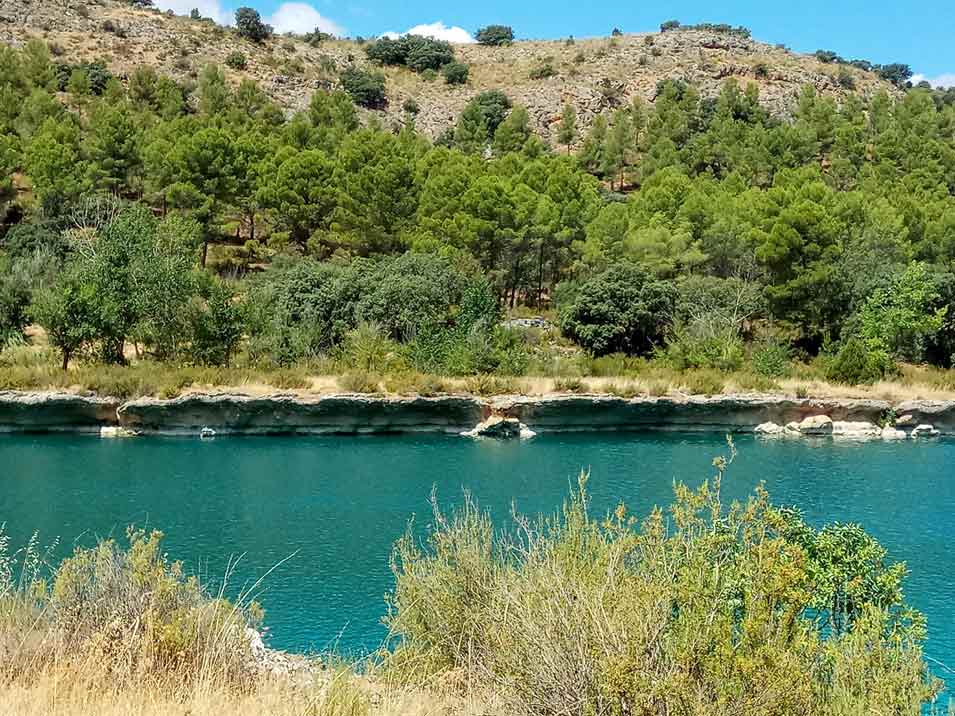
The middle lagoons have spectacular tufa barriers dotted with areas with sandy beaches. The upper and lower lagoons are more marshy, ideal as a habitat for birds and amphibians.
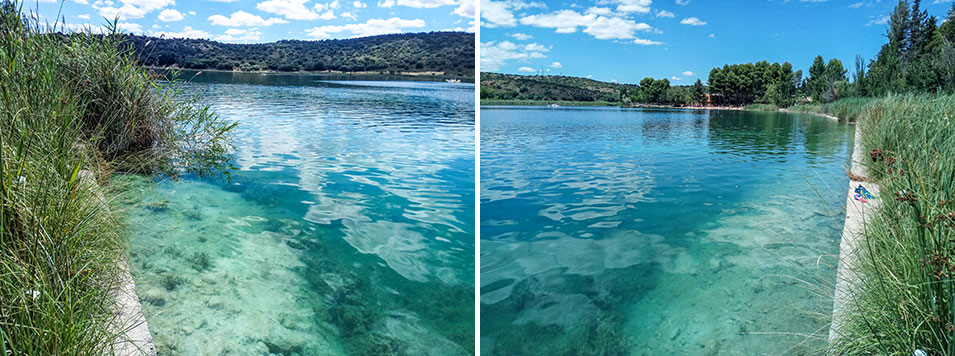
The middle lagoons, which are more suitable for swimming, have some hotels and restaurants at their shores.
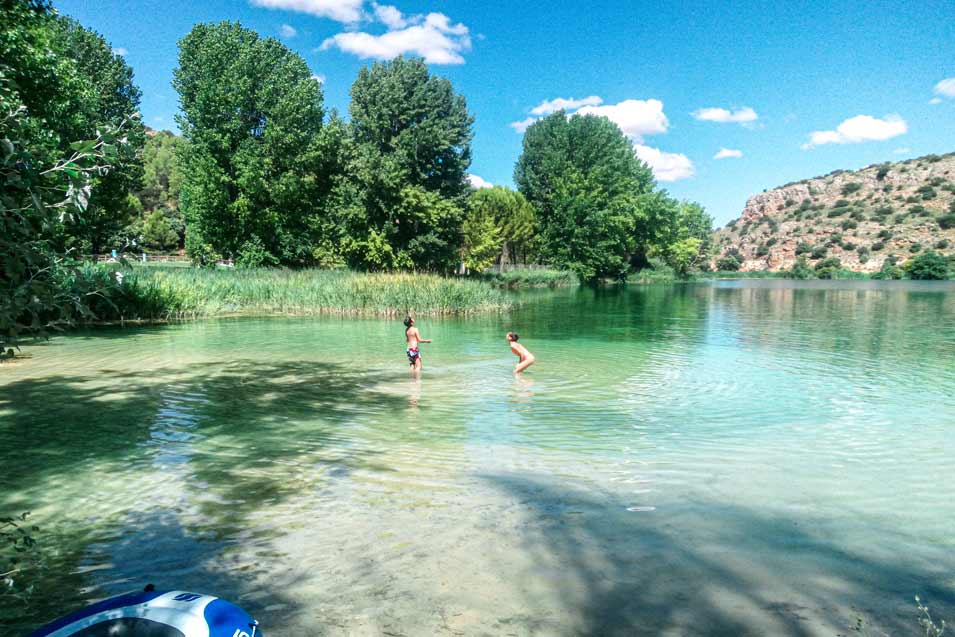
As it is such an extensive area, there are places where you will be surrounded by trees and small forests, while others have almost no vegetation and show the silhouette of the lagoons perfectly.
%
DIFFICULTY LEVEL
SWIMMING HOLES
IN HUESCA

Check out the best Swimming Holes & Places to Swim INLAND!
Salto de Bierge
Cascada de Sorrosal
Pozán de Vero
Cinca River
Puyarruego
SWIMMING HOLES
IN VALENCIA

Check out the best Swimming Holes & Places to Swim INLAND!
Pou Clar
Salto de Chella
Bolbaite
Chorradores de Navarrés
Salto de Millares
Cortes de Pallás - Reservoir
Cortes de Pallás - River
Gorgo de la Escalera
Charcos de Quesa
Cueva Turche
Bugarra
Gestalgar
Azud de Tuéjar
Pozas del Ral
Barranco Otonel
SWIMMING HOLES
IN ALICANTE

Check out the best Swimming Holes & Places to Swim INLAND!
Algar Waterfalls
Toll Blau
Barranco de la Encantada
Salt de Jijona
Guadalest Reservoir
Swimming Safety
Read these Tips
&
be Safe
when Wild Swimming
DESTINATIONS
UK
Spain
Bali
Belize
Mexico
Trinidad and Tobago
Costa Rica
India
Martinique
Keep it Clean!
The Rules

![]() Like us on Facebook!
Like us on Facebook!
![]() Facebook Posts
Facebook Posts
HOW TO GET TO - Lagunas de Ruidera
Getting There
Transport Options
Getting There
How to get to Lagunas de Ruidera
It is very easy to get to the Lagunas de Ruidera, as they are very well signposted and located in a flat area, without big mountains or curves.
They are about 109 km from Ciudad Real and 95 km from Albacete. From Albacete by car it takes about 1 hour and 30 minutes on the N-430. From Madrid it is 211 km (about 2 h and 20 min) on the A-4, taking the turn-off at Manzanares on the N-340 towards Albacete.
The lakes are located 100 m from the village of Ruidera (which gives the lagoons its name) and 14.5 km from Ossa de Montiel. In both villages, there are several signposts to the lagoons.
Parking
There are car parks in many areas of the park. You can drive around the lagoons and you will see them. They are usually near viewpoints or in areas where some kind of trail begins. You can combine the two and do stretches by car and then go for a walk. Parking is free. Some of the viewpoints are:
Viewpoint Laguna Lengua
Viewpoint Laguna Redondilla
Viewpoint Laguna Batana
Location
Coordinates
Villages Nearby
Difficulty Level
Walking Time
Drinking Water Spots
%
DIFFICULTY LEVEL
USEFUL INFORMATION - Lagunas de Ruidera
Handy Things to Know
When to Go
The Lagunas de Ruidera Natural Park is impressive at any time of the year.
In summer, many of the lagoons are transformed into bustling beach spots, with families, sunbathers, and people practising water activities. Especially on weekends, it’s packed. Yet, in other lagoons that are not so suitable for bathing, there is hardly anyone. In summer, some lakes and waterfalls can be dry.
After periods of rain and in spring, the waterfalls and lagoons carry more water. The ideal time to go is during the week and during April, May, June, September, and even October. You will contribute to sustainability and enjoy the beauty of the park more. From November to February, you may not see anyone.
There are no opening hours. It is always open.
Price
Activities
Kayaking and paddle surfing
Non-motorised boating (see below under Restrictions on which lagoons it is allowed).
Pedal boats
Hiking
Picnicking
For more details of the activities, see below the Things to do section.
Facilities
Kids
Dogs
Skinny Dipping
Wheelchair Access
Restrictions
It is forbidden to make fires and use barbecues.
Do not litter or bury rubbish. Use the litter bins and containers.
Respect nature, plants, animals and fossils.
Respect the silence of nature. Everyone has the right to enjoy the Park.
It is forbidden to empty tanks and leave waste inside the park and its accesses.
Follow the indications of the Park staff and follow the established paths.
It is forbidden to camp freely or spend the night in vehicles inside the park. You must use the camping sites.
It is forbidden to use the water in the lagoons to wash your belongings, cars, etc.
Do not throw objects that could contaminate the water.
Respect the caution signs in the bathing areas and the prohibition of access to the barriers.
Motor-driven boats are forbidden. Boating is prohibited in the Conceja, Coladilla and Cenagosa lagoons.
Fishing is forbidden in the bathing areas from the 1st June to the 30th of September (only no kill fishing).
Bathing is forbidden in the travertine barriers (where the waterfalls originate) and nature reserve areas marked by the park.
Remember that soap and detergents should not be used in rivers and pools. Also, most sun creams contaminate the water, try to apply them well before taking a dip.
(Scientists have found that sunscreen releases significant amounts of titanium dioxide, which damages aquatic life.
Soaps have phosphates, are also non-biodegradable and harm the environment).
You may be fined if you do not respect these warnings.
Managed by
Things to Do – Lagunas de Ruidera
Things to Do
Things to do near Lagunas de Ruidera
Don’t miss the views from the viewpoints. The main ones are on the sides of the lagoons and usually have parking.
Apart from swimming, there are many water activities available. Some can be done depending on the amount of water in the lagoons. These include kayaking, paddle surfing, canoeing, pedal boats and snorkelling. You can bring your boards or hire them. There are diving courses (many of the lagoons are connected by underground caves) and sailing (motorboats are prohibited). Sailing is possible only in the Conceja, Coladilla and Cenagosa lagoons. Prices start at €15 for paddle surfing or kayaking and go up to €40 for diving lessons.
There are plenty of hiking trails and 7 marked trails. One of the most beautiful is a circular route (14 km) that starts at the El Hundimiento waterfall and runs through the Laguna del Rey, Colgada, Batana and Santo Morcillo lagoons. It has almost no gradient, so it is very easy and a good option to do with children. Here is the route on a map.
The Lagunas de Ruidera park has plenty of itineraries for walking or cycling, which you can see in the link. Some of these routes are long and can be done on bicycles, which can be rented.
You can also go caving or paragliding here.
There are guided tours in 4×4, on horseback and foot.
The Peñarroya reservoir, of a beautiful deep blue colour, has the 12th-century Peñarroya Castle on its shore. It is very well preserved and worth visiting. The scenery is beautiful. You will have a spectacular view of the Peñarroya reservoir surrounded by land with ochre tones when climbing up the castle walls.
At the other end of the Lagunas de Ruidera Nature Reserve are the Rochafrida Castle (less well preserved than the Peñaroya Castle) and the Montesinos Cave. The cave is a karst cavity with a depth of 80 metres. Inside there is a small river.
To observe the animals, it is advisable to take binoculars.
There is an Ethnographic Museum in Ossa de Montiel.
Where to Eat
The gastronomy of La Mancha cuisine stands out for its lamb, game, gazpachos, stew, ratatouille, fried rabbit with garlic or tomato, chorizos, cheeses and wines.
Accommodation
There are many rural houses, hotels and campsites in the area. Free camping is forbidden in the park, but there are 3 campsites: Camping de Montiel Montesinos, Camping los Batanes and Camping los Molinos located in Ruidera. Overnight parking is prohibited inside the park, but campers and motorhomes can stay overnight at the campsites.
You can also stay in a nearby village.
Rural Houses:
Casas Rurales Pernales*.
Rural House El Descanso del Andante
Cabañas Cueva de Montesinos
Rural Houses Lagunas de Ruidera
Rural House La Torca**
Ruidera and Tomelloso Apartment
Rural House El Lio
Rural House La Cachumba
Rural Houses Quixote and Sancho
Hotels:
Hotel Rural Albamanjon***
Guadiana Guesthouse***
Aparthotel Doña Ruidera**
Geography
Altitude
Size
Many of the lagoons are less than 500 m long. The largest are the Laguna del Rey (length 1400 m), the Laguna de San Pedro (2000 m) and the Laguna Colgada (2400 m) which has a depth of 40 m. From the first to the last lagoon there is an extension of about 25 km.
Under Foot
Maximum Water Depth
Minimum Swimming Level
Shade
How Clean is Swimming Spot?
Water
Underwater
Water Temperature
Water Colour
How Clean is Water?
SWIMMING HOLES
IN VALENCIA

Check out the best Swimming Holes & Places to Swim INLAND!
Pou Clar
Salto de Chella
Bolbaite
Chorradores de Navarrés
Salto de Millares
Cortes de Pallás - Reservoir
Cortes de Pallás - River
Gorgo de la Escalera
Charcos de Quesa
Cueva Turche
Bugarra
Gestalgar
Azud de Tuéjar
Pozas del Ral
Barranco Otonel
SWIMMING HOLES
IN HUESCA

Check out the best Swimming Holes & Places to Swim INLAND!
Salto de Bierge
Cascada de Sorrosal
Pozán de Vero
Cinca River
Puyarruego
SWIMMING HOLES
IN ALICANTE

Check out the best Swimming Holes & Places to Swim INLAND!
Algar Waterfalls
Toll Blau
Barranco de la Encantada
Salt de Jijona
Guadalest Reservoir
Keep it Clean!
The Rules

Swimming Safety
Read these Tips
&
be Safe
when Wild Swimming
DESTINATIONS
UK
Spain
Bali
Belize
Mexico
Trinidad and Tobago
Costa Rica
India
Martinique
![]() Like us on Facebook!
Like us on Facebook!

